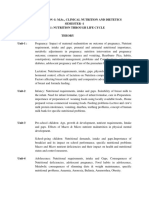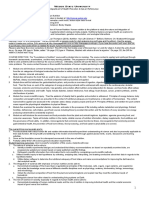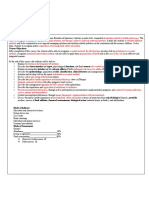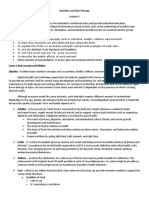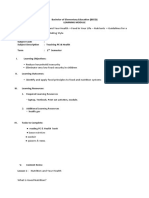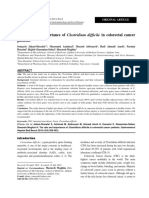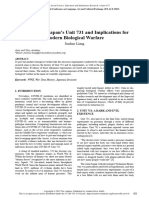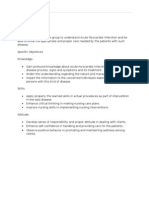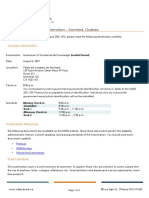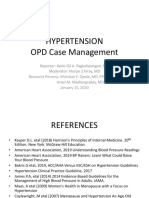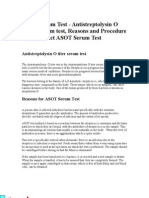COMMUNITY NUTRITION LECTURE HOURS 45 PH 15 CF 4
Contact Hours: 30
Prerequisite(s): Biomedical Sciences
Course Purpose
To equip learners with knowledge, skills and attitudes necessary for the
implementation of community health Nutrition.
Expected Learning Outcomes
At the end of the course the learner should be able to:
1. Demonstrate an understanding of community health nutrition,
nutritional disorders and their management
2. Contribute in the provision of nutritional health education in a
community
3. Describe the pathology and epidemiology and management of
nutritional and metabolic disorders
4. Participate in monitoring and evaluation of community nutrition
programmes
5. Demonstrate the scientific basis of various techniques used in
investigating nutritional and metabolic disorders and interpretation of
the findings.
Course Content:
Concepts of Health and Nutrition: Main Food Groups-Proteins, fats,
carbohydrates, vitamins, minerals, water and fibre. Outline classification,
causes, features and management of nutritional disorders like Kwashiorkor,
marasmus, scurvy, beriberi, rickets, pellagra, goitre and nutritional anaemia.
Introduction to community health and nutrition: Definition of
community health and nutrition, Principles of community health and
nutrition, Laws governing community health provision, Role of the Clinical
Officers in community health provision; Concepts of Health Education
and community based health care: Nutrition in the lifecycle, Diet for the
well, infants, school going children, adolescents, pregnant and lactating
mothers and the age ; Dietary requirements for the individual, family and
community; Concept of Food hygiene: food infection and food poisoning,
common poisonous foods, food borne diseases; Public Health Act (Cap 242),
Humans and nutrition:
Assessment of nutrition status; Nutritional status assessment tools as
well as dietary standards; common nutrition problems afflicting the world
populations, their prevention and management Integrated management for
adult malnutrition: Integrated management of child malnutrition;
Anthropometric measurements; BMI, MUAC; Monitoring and evaluation:
Community nutrition survey. Nutrition Interventions; Nutrition in
emergencies
Teaching Methodologies
Lectures, Assignments, Tutorials, Demonstrations, Case Studies,
Class Presentations, Group discussions, community visits
�Instructional Materials/equipment
Course notes, marker boards, markers, dusters, computer and LCD
projector.
Course Assessment
Continuous Assessment Tests (CATS) 10%, Practical 10%,
Assignments, 10%, End of Semester Examination 70%.
Course Textbooks
1. Hall, W. S. (2010). Nutrition and Dietetics. Nabu Press. ISBN-13:
978-1-146-53583-0, ISBN: 1-146-53583-X.
2. Hall, W. S. (2004). A Manual for Students of Medicine, Trained
Nurses and Dietitians. Kessinger Publishing. ISBN-13: 978-1-
4179-6157-3, ISBN: 1-4179-6157-0.
3. Gandy, J., Madden, A. and Holdsworth, M. (2012). Oxford
Handbook of Nutrition and Dietetics. Oxford University Press.
ISBN-13: 978-0-19-958582-3, ISBN: 0-19-958582-2.
Course Journals
1. Journal of the Academy of Nutrition and Dietetics. Elsevier. ISSN:
22122672.
2. Journal of Human Nutrition and Dietetics. Wiley-Blackwell. ISSN:
09523871, 1365277X.
3. World Review of Nutrition and Dietetics. S. Karger AG.ISSN: 16623975,
00842230.
Reference Textbooks
1. Ansari, S. (2012). Nutrition and Dietetics. Arise Publishers &
Distributors. ISBN-13: 978-93-81031-05-6, ISBN: 93-81031-05-3.
2. Sharma, A. K. (2012). Human Nutrition and Dietetics. Kaveri
Book. ISBN-13: 978-93-5030-060-2, ISBN: 93-5030-060-5
3. Davidson, S., Passmore, R. and Brock, J. F. (1972). Human
Nutrition and Dietetics. Churchill Livingstone. ISBN-13: 978-0-
443-00947-1, ISBN: 0-443-00947-3.
Reference Journals
1. Nutrition and Dietetics. Wiley-Blackwell. ISSN: 17470080, 14466368.
2. Journal of Nutrition. American Society for Nutrition. ISSN: 00223166,
15416100.
3. Nutrition. Elsevier Inc. ISSN: 08999007, 18731244.




